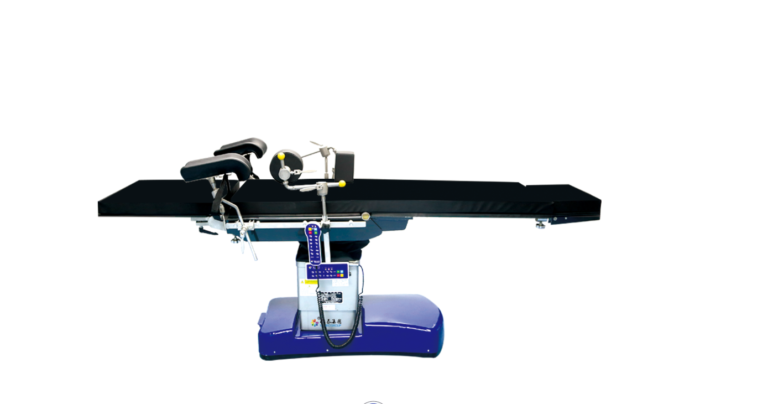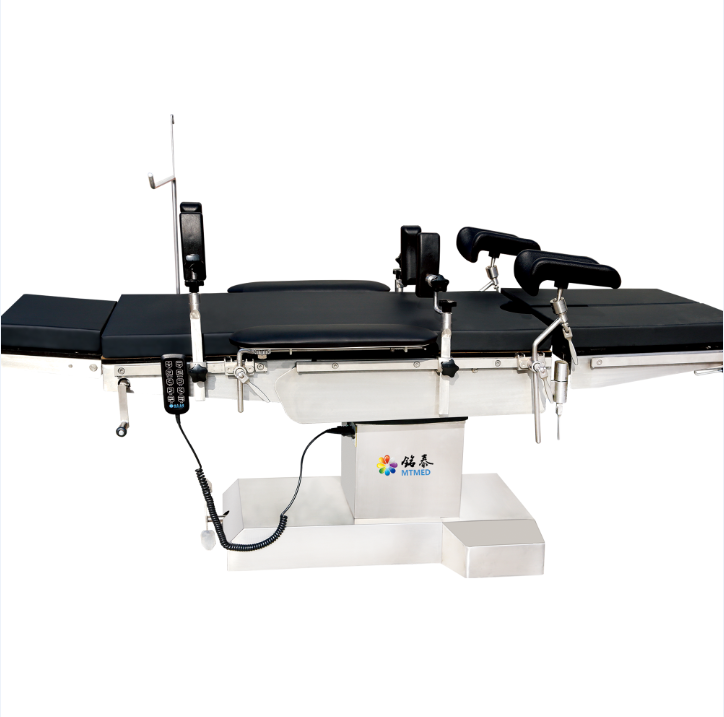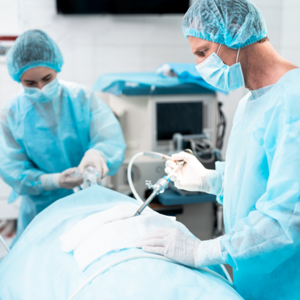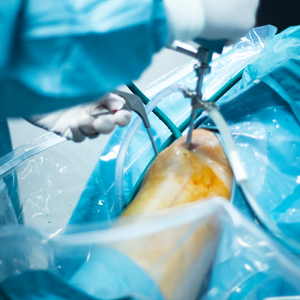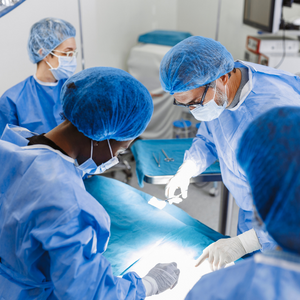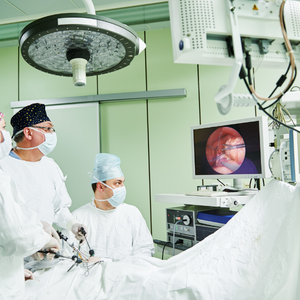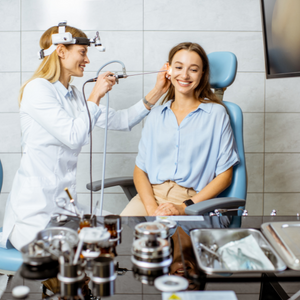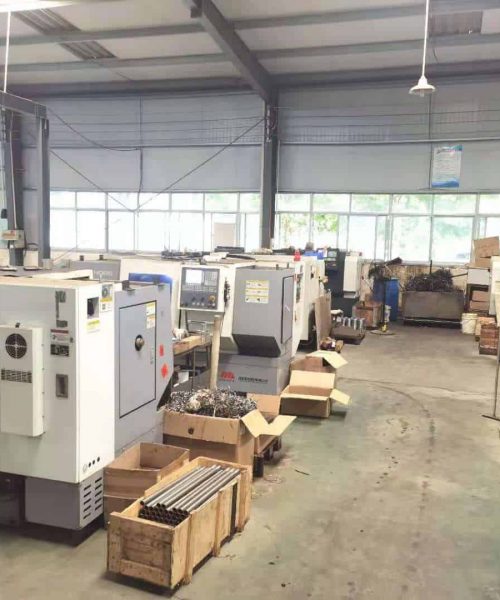What Does a Surgery Table Do?
A surgery table is a specially designed table used to position and supports the patient during surgery. It supports the patient’s weight and allows the surgical team to perform complex procedures by allowing easy access to all parts of the patient’s body.
What Are the Features of a Surgery Table?
Surgical table features include:
1. C-arm compatibility, which allows for fluoroscopic imaging during surgery.
2. Multiple patient positioning options such as reverse Trendelenburg, Trendelenburg, lateral tilt, etc.
3. Manual or automatic articulation to help you get your patients in position.
4. Radiographic contrast panel to help you visualize your patient’s anatomy.
What Are the Different Types of Surgery Tables?
We can classify the operating table into universal and specialized operating tables.
Universal operating tables are general-purpose operating tables that can be used for various operations on multiple human organs. According to different patient positions (lying, standing, sitting), there are four types of universal operation tables.
Specialized operation tables are used for specific operations on specific organs. For example, an orthopedic operation table is only suitable for orthopedic surgery, and a gynecological operation bed is only suitable for gynecological surgery. Specialized operation tables have their unique functions and design characteristics.
What Are the Advantages of Using a Surgery Table?
Surgery table advantages include:
Increased comfort for the patient. Surgical tables are designed to maximize patient comfort during surgery. They allow surgeons to position the patient in ways that make them comfortable during surgery. They also often feature accessories like leg holders and headrests to help immobilize patients who may be at risk for injury or require extra stability during surgery.
Improved patient care. Surgical tables allow surgeons to perform intricate and complex surgeries, resulting in better patient outcomes. Surgery tables are usually equipped with advanced features that enhance precision and control during surgery. Anesthesia machines, lighting systems, imaging devices, and other devices can be attached to the surgical table so that surgeons can access them when needed.
Better surgical team coordination. Surgery tables are designed to accommodate multiple members of a surgical team simultaneously. More than one person can perform tasks like monitoring vital signs or administering medication simultaneously, so operations run more smoothly.
What is the Difference Between an or and a Procedure Table?
An OR table is designed to be the primary imaging platform for the operating room. As such, it has features that are only necessary for the OR.
There are two major differences between an OR table and a procedure table. The first is that OR tables have different accessories available on each side of the table. Most procedure tables only have a hand control on one side, and all accessories are on that one side. This means that we would have to walk around the table to find an instrument or part of the patient.
The other Difference is that OR tables have separate columns on each side of the floor lock/foot pedal assembly. This means that you can move your patient from one position to another without adjusting both sides equally (elevation and lateral movement).
What Are Some Common Applications of Surgery Tables?
Surgical tables allow surgeons to perform procedures more efficiently and effectively.
The most common situations that require the use of a surgery table include:
- Radiology
- Endoscopy
- Ophthalmology
- Orthopedics
- Cardiovascular surgery
- Neurosurgery
- Urology
How Does a Surgery Table Work?
Surgery tables are designed to function as temporary operating tables used for various minor and major surgeries. They are designed to hold patients comfortably while undergoing medical procedures. The table also allows the surgeon and other doctors to access the patient from all sides. A surgery table is often equipped with a padded tabletop that can be adjusted to different heights, and it also has an adjustable bed.
- Surgery tables are available in different models, which include the following:
- Surgical tables that have been specially designed for gynecological procedures
- Surgical tables that have been specially designed for abdominal procedures
- Surgical tables that have been specially designed for orthopedic procedures
- Surgical tables that have been specially designed for pediatric procedures
The surgical table has a built-in battery backup system, so it can be used in remote locations where electricity is unavailable. It also has an adjustable headrest to support the patient’s head if they need to lie flat on their back during the surgical procedure.
How Do I Choose a Surgical Table for My Medical Facility?
The best way to find the right surgical table for your medical facility is to consider how you plan to use it. Depending on your needs, you may want a general-purpose table used in many different types of procedures or a model designed for specific applications such as radiology.
Here are some factors to consider:
● Decide which features are important for your facility.
● Consider the table’s top type, size, and capacity.
● Optimize the table’s imaging capabilities.
● Prioritize patient comfort and safety.
What Are the Features of Our Surgical Tables, and How Can They Help You Improve Patient Care and Safety in Your Medical Facility?
The features of our surgical tables are designed to help you improve patient care and safety.
Some of the features that our surgical tables include:
-Easy to clean and disinfect
-Electrically adjustable height and position
-Multiple accessories to meet different surgery requirements
-High-quality materials to ensure the strength and stability of the operating table.
What is the Difference Between a Surgical Table and a Surgical Chair?
The Difference between a surgical table and a surgical chair is the main factors: who is being operated on, the type of surgery, and the surgeon’s preference.
A surgical table is used when the patient is lying down on their back with their legs elevated on stirrups. The surgical chair is used when the patient is sitting down or reclining.
Can a Surgical Table Be Used for All Types of Procedures?
Yes, you can use one surgical table for all types of procedures. However, different types of procedures have different requirements. For example, cardiac patients need a specific table tilt angle and height. The same is true for orthopedic surgery and other specialties.
What is the Importance of a Rectangular Tubing in an or Table?
A rectangular tube is the tubing shape of choice for most tables.
The primary benefit of the rectangular shape is that it allows more space for the legs, whether they be a pedestal base or trestle style base. A round tabletop requires a larger diameter tube to support the legs than a square or rectangular shape, which reduces the space available for legs.
A secondary benefit of a rectangular tube is that it allows for a greater number of legs to be placed under the tabletop. This increases stability and decreases the likelihood of wobbling when someone bumps into the table quickly or sits down at it.
What Accessories Are for Sale with a Surgical Table?
Here is a list of the most popular surgical table accessories:
1. C-Arm Compatible Surgical Table
2. Surgical Stretcher
3. Imaging System
4. Controller
5. Side Rails
6. Battery Backup
7. Accessories Mounts
What Standards Does an or Table Adhere To?
Surgical Table Standards:
• AAMI ES60601-1 General Requirements for Medical Electrical Equipment and Systems
• ISO 14635-2 Hydraulic Fluid Power – General Symbols and Circuit Diagrams.
• UL 61010-1 Safety Requirements for Electrical Equipment for Measurement, Control, and Laboratory Use – Part 1: General Requirements
• UL 2601-1 Medical Electrical Equipment – Part 1: General Requirements for Basic Safety and Essential Performance
• ASTM F 2089 Standard Guide for Patient Examination Tables for Medical Settings
• ASTM F 2088 Standard Specification for Stainless Steel Tables, Sinks, Cabinets, Shelves, Benches, and Other Miscellaneous Fabricated Articles for Surgical, Medical, Dental, or Related Health Care Facilities
What Does Ergonomic Mean and How Does It Apply to a Surgery
Table?
Ergonomics is the science of designing machines, tools, and systems to maximize human comfort and productivity. Concerning a surgical table, this means designing the table to allow surgeons to work comfortably in various positions for extended periods.
One of the most important ways surgical tables are ergonomic is that they can be adjusted to provide comfortable working positions for surgeons performing different types of surgeries. Surgical tables should also be designed so that surgeons can easily adjust the table as needed during surgery.
Are There Any Similarities Between an Operating Table and an X-ray Table?
The main similarity is that they both have a flat surface. But other than that, they are very different.
A surgical table is often used in the operating room so that an individual can be laid on it while a surgeon operates. These tables are usually attached to a foot pedal so that the height of the table can be adjusted to fit the needs of the surgeons and nurses. The height is also adjustable to be lowered or raised depending on what part of the body needs to be worked on and how accessible it needs to be for the surgeons.
An x-ray table is used exclusively for x-rays; these tables are often made out of lead, sometimes wrapped in plastic because they need to be able to protect individuals from radiation. They also come with an x-ray machine attachment so that a person can be moved around while being photographed and have their arms, legs, and head immobilized during the photographing process.
What Kind of Table is Used for Back Surgery
The different tables used for spine surgery are:
1) general-purpose table (good for posterior spine surgery)
2) O.R only table (good for posterior and anterior spine surgery)
3) C-arm table (good for anterior spine surgery)
Can You Use Inversion Table After Back Surgery
In the first place, there are many different types of back surgery, and not all are applicable to use with an inversion table. The most common type of surgery that would benefit from an inversion table is a discectomy. This type of surgery involves removing or repairing herniated disc material pressing on a nerve root and causing pain.
If you have had this type of surgery, you can use an inversion table as long as your surgeon gives his approval.
An inversion table helps relax the muscles surrounding the spine and relieves pressure from the compressed discs. However, if you have had any back fusion surgery, it is not recommended that you use an inversion table because it will put too much pressure on the fused area.
There are many advantages to using an inversion table after back surgery besides relieving pressure from compressed discs and relaxing muscles. The decompression to the spine from inverting can improve blood flow, which promotes healing and provides oxygen and nutrients to injured areas. It also helps stretch ligaments, tendons, and muscles, reducing stiffness and increasing flexibility.
Can I Use an Inversion Table After Hip Replacement Surgery?
It would be best not to use an inversion table after hip replacement surgery until you are cleared. Inversion tables are used to get rid of back pain. However, using an inversion table after hip replacement surgery could cause injury and damage to the joint replacement.
Inversion tables are used for back pain and decompression of the spine. Many people use them to get rid of back pain. This is done by hanging upside down to relieve pain and pressure caused by gravity pressing on the spine while a person is in an upright position.
Using an inversion table after hip replacement surgery could cause problems with your recovery. Doctors usually recommend keeping pressure off the new joint by not bending, lifting, or twisting it while healing. Lifting heavy items or putting any pressure on the joint could cause permanent damage and ruin the procedure.
After hip replacement surgery, it is important to avoid doing anything that will put pressure on your joints until you have fully recovered from the procedure. Using an inversion table before you have been cleared to do so could lead to serious injuries that would take longer to heal than if you had used caution and allowed your body time to recover from surgery before using it again.
Can I Use an Inversion Table After Cataract Surgery
You must wait until your eye has healed before using an inversion table. While each person heals at a different rate, and it will depend upon the type of surgery you had, it takes up to 8 weeks for cataract surgery patients to recover full vision. This is especially true if you had complications during surgery or after surgery. You may experience swelling and irritation in your eye immediately following surgery, and it may take up to 4 weeks before your vision stabilizes. Your doctor will tell you.
